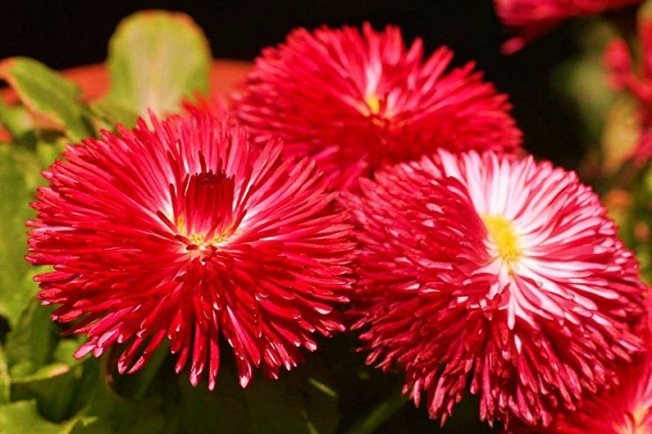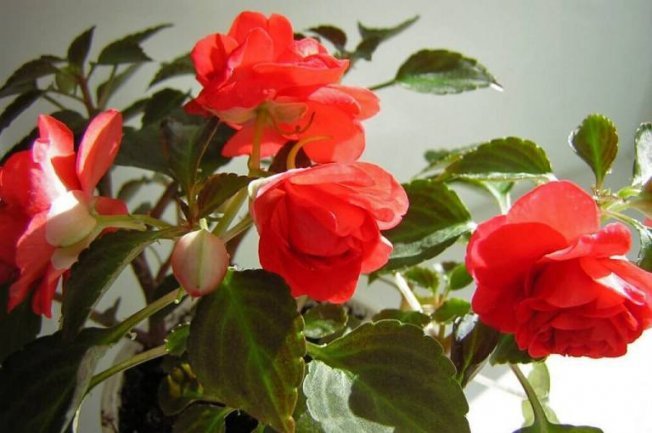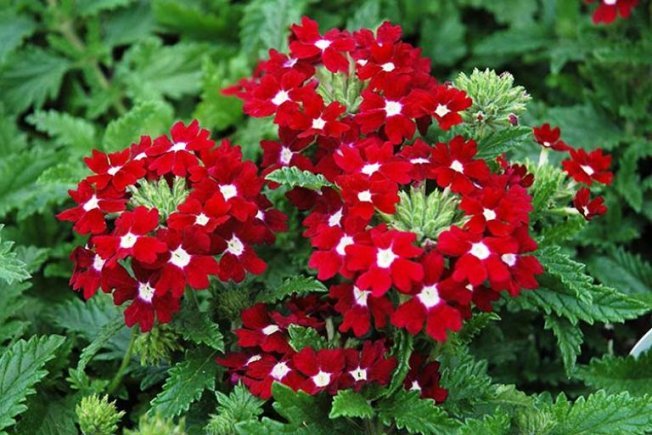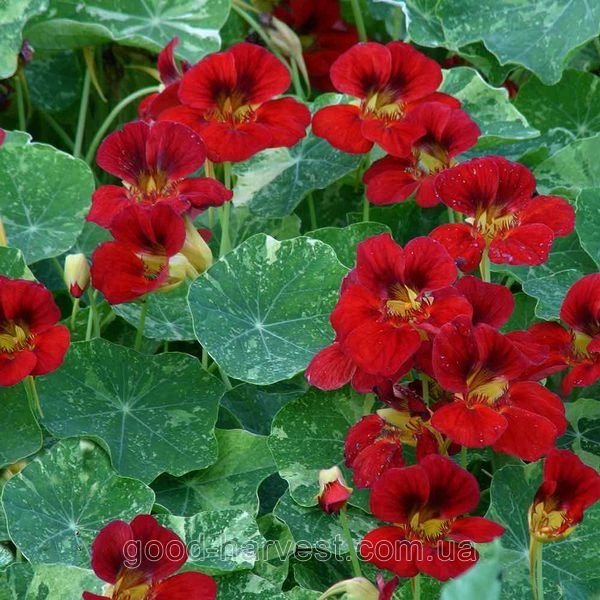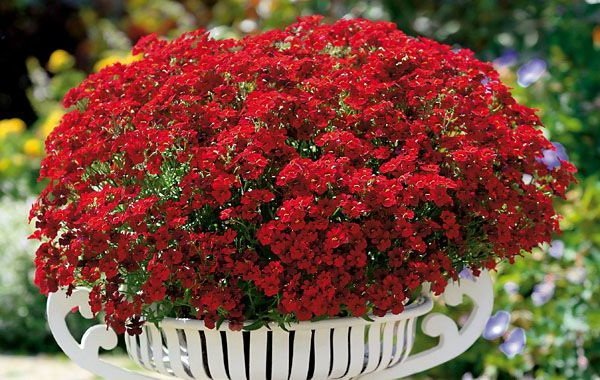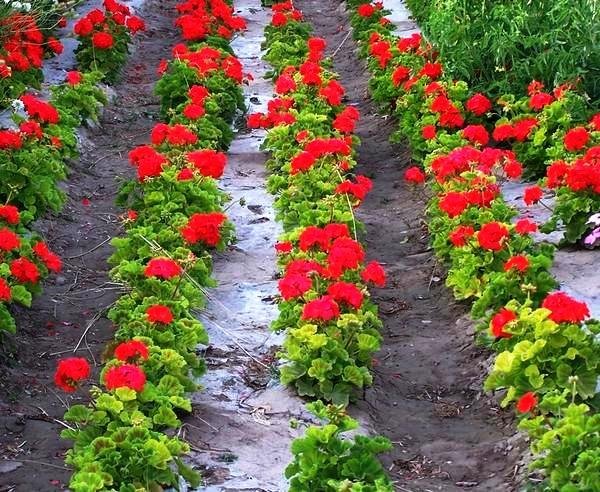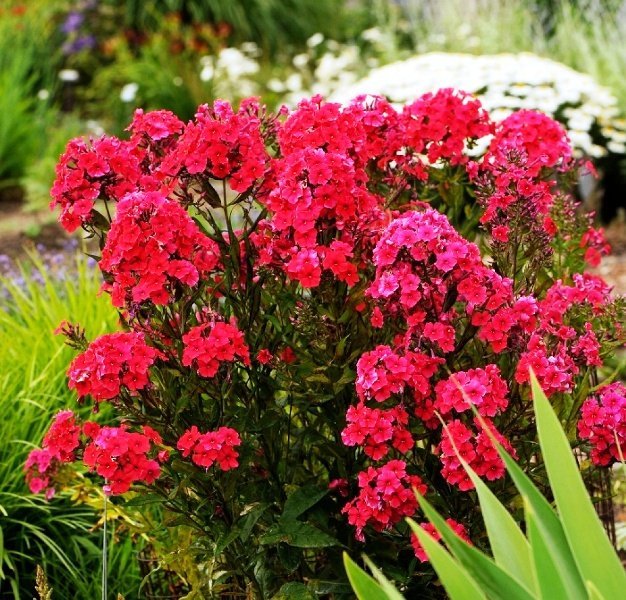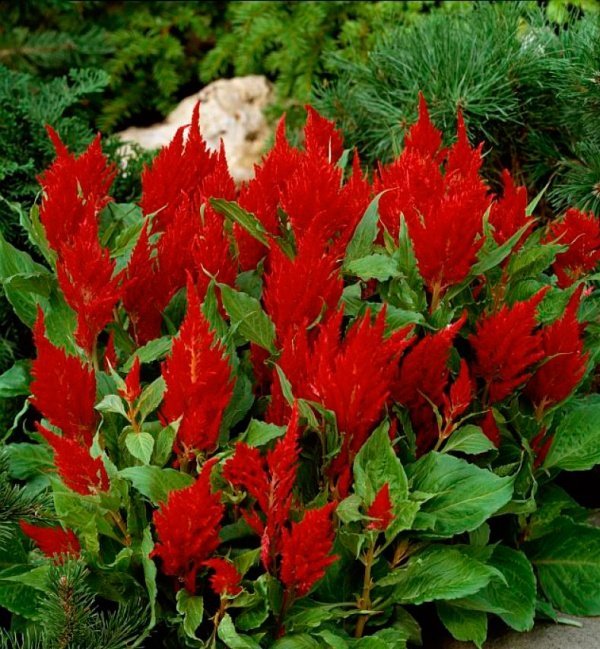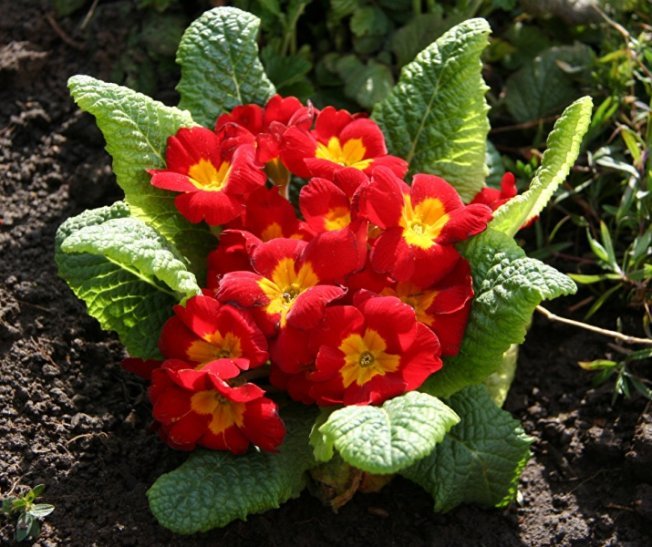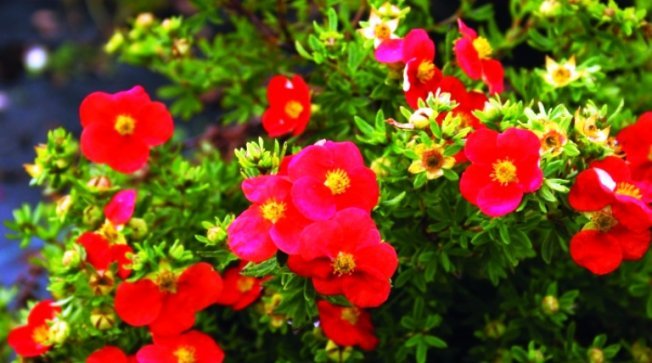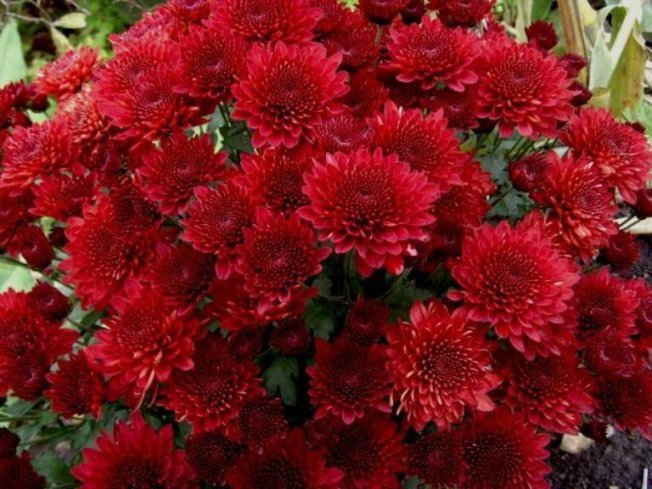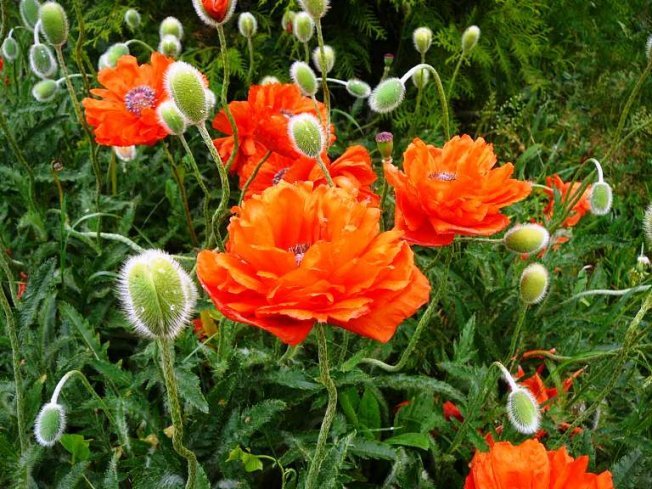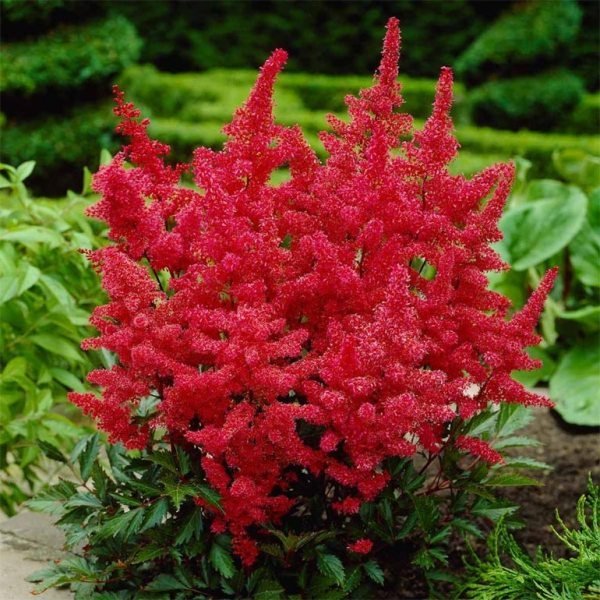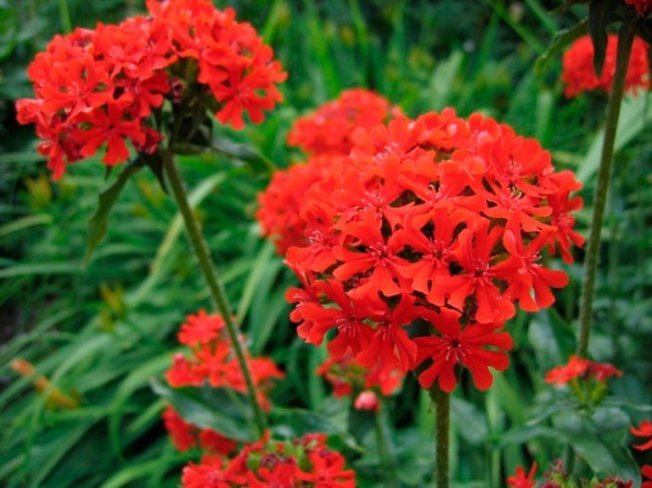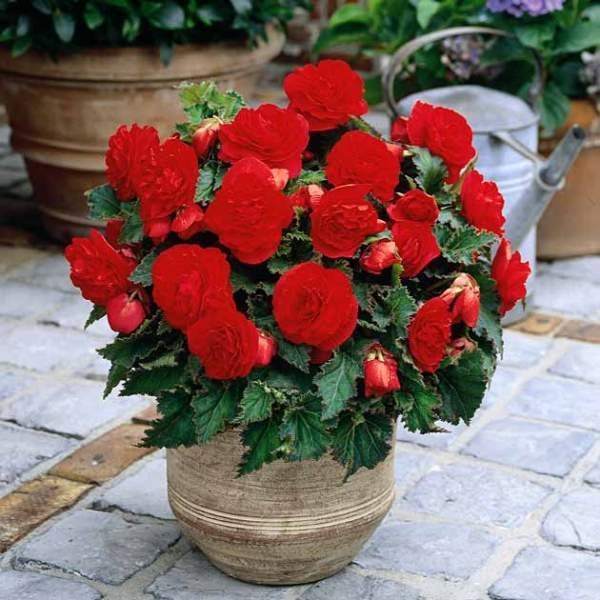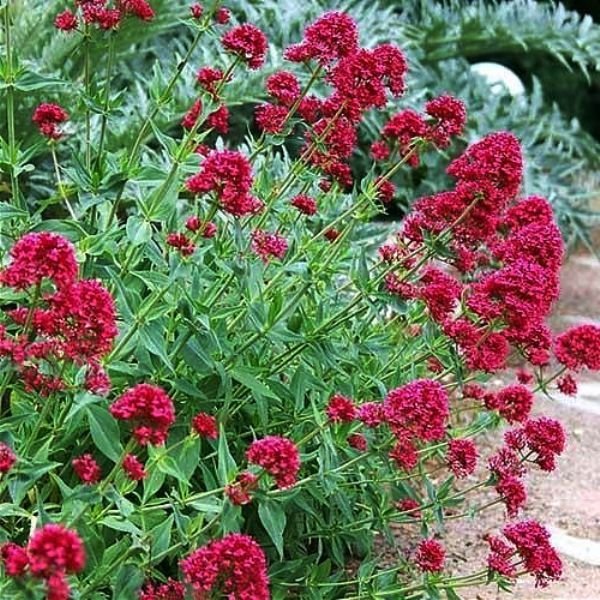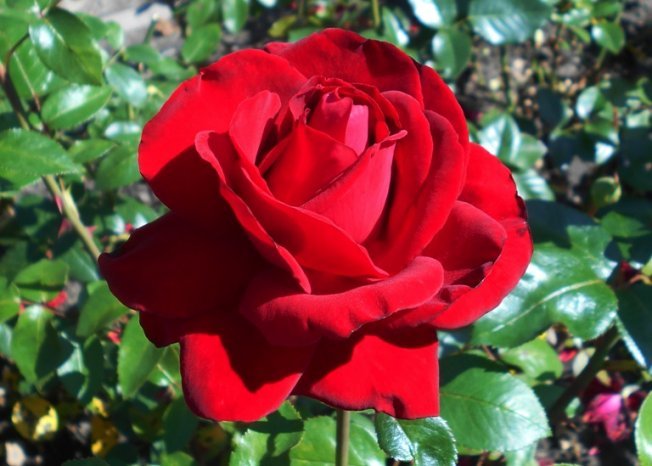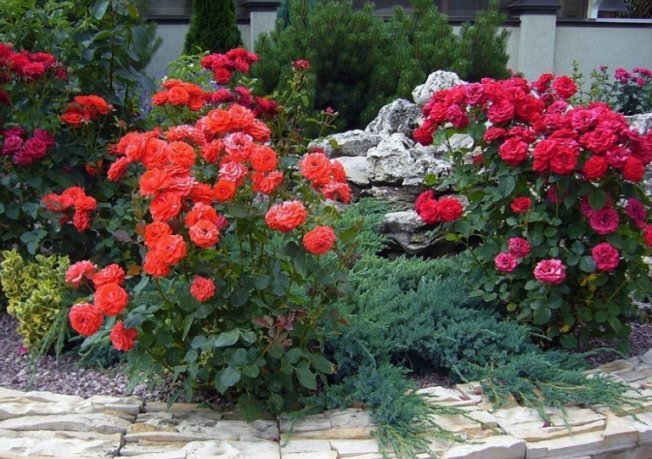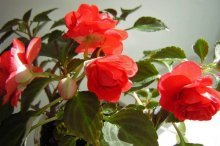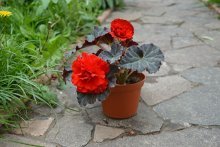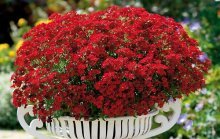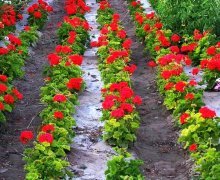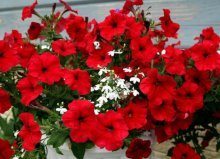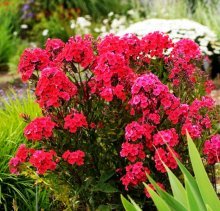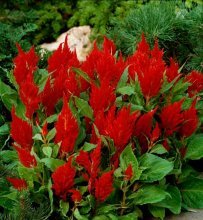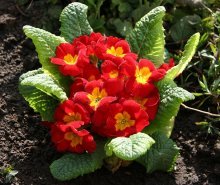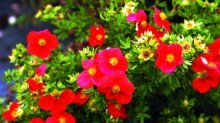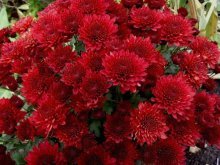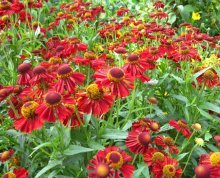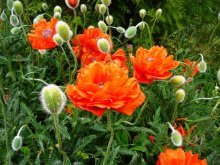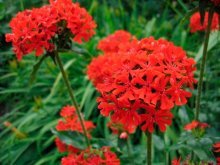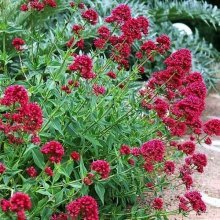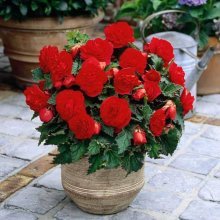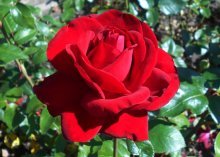Red flowers for flower beds, photos and names of the most popular
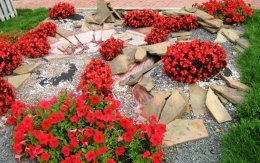
The art of colorism involves drawing up landscape compositions based on the principle of grouping plants according to the shade of leaves and flowers. These can be contrasting combinations that attract attention with a wealth of bright and muted colors, or monochrome, but no less effective compositions. Let's look at what red flowers look like in the photo and find out the names of plants that can be used to create a flower bed of continuous flowering.
Content:
- Red color in landscape design - for those who like it hot
- Red flowers: photo and description
- Low-growing perennial crops with red flowers
- Tall perennials
- Tips for decorating a flower bed
Red color in landscape design - for those who like it hot
Psychologists say that shades of red have an irritating effect on the nervous system. Practice shows that the effect on the psyche is not so strong as to change the emotional state.
But the fiery color is great for highlighting, attracting attention, it indicates what should be looked at first. In addition, it is a symbol of beauty, love, energy.
Contemplating red flowers framed by green leaves helps improve your mood. And if in bright sunlight it seems that the red color blinds the eyes, then in cloudy weather it becomes moderately bright, allowing you to admire the subtlety of the structure of the petals.It is recommended to use plants with red flowers in regions with cloudy and rainy summers (Northwestern and Central regions of the Russian Federation).
Red flowers for a flower bed are a real find for those who like to walk through the illuminated garden at night: in warm artificial lighting, shades of red look amazingly beautiful.
Plantings of red annuals will help highlight exactly those areas in the garden that you think are worthy of increased attention.
If the windows of a country house are small, then it makes sense to look at the photo and find out the names of red flowers that can be grown in flowerpots: bright flowers hung around the windows can radically change the appearance of a facade with dim windows.
In flower beds, red flowers look elegant and well-groomed, even if:
- plantings are slightly sparse;
- there are stains on the sheets;
- Some of the inflorescences have dried out.
Red flowers: photo and description
Let's look at red annuals for flower beds; names and photos will help you remember the most interesting ones and use them when planning garden compositions.
Adonis - used to decorate gardens since the 17th century.
It is sown with seeds, which can be stored for only 1 year. Adonis love light soils and morning sun, they rarely get sick and are practically not affected by harmful insects. Can be grown as a perennial.
Antirrinum, better known as Snapdragon.
It has been cultivated for more than half a millennium; during this period, hundreds of its varieties have been created, including those with red flowers. In warm climates, the seeds are sown in the ground; in the central zone, it is better to plant snapdragons as seedlings. It is advisable to choose a site for planting that is protected from the winds.Twice a season the bushes are fed with complex fertilizers. Tall varieties of snapdragon require garter.
Asters for a flower bed with red flowers can be chosen miniature (up to 20 cm high) and tall (up to 120 cm high).
The leaves and flowers themselves may also differ significantly. Asters are sown in the ground or under a film cover. The plants respond well to transplanting and picking, so excess bushes can be planted throughout the area. It is not recommended to plan to plant asters in areas that are too wet. Fresh manure should not be used to fertilize asters.
Balsam.
Its lush bushes are worthy of decorating any flower bed. It grows slowly, so it is advisable to plant it as seedlings. Seedlings require picking; mature seedlings are pinched. Caring for balsam involves systematic watering and loosening the soil around the bushes.
Begonia is usually grown in hanging flowerpots, but if planted in an area protected from the wind and systematically fertilized with potassium-phosphorus compounds, the flower can be grown in open ground.
Before sowing, the seeds are treated with fungicides; after the appearance of 2 true leaves, the seedlings are planted in separate pots.
Verbena attracts attention with its long flowering, until mid-autumn.
Pinching the branches and removing fading inflorescences will allow you to get a bright blooming bouquet with a diameter of about half a meter. Verbena is planted as seedlings; during the flowering period and before it begins, the plants are fed with a mixture of Agricola and nitrophoska.
Nasturtium is a plant without special requirements for soil and care.
It forms a beautiful bush in any weather conditions and can bloom before the onset of cold weather.Nasturtium is sown in the ground, the sowing density is adjusted depending on the varieties, and they can be dwarf, bush or climbing. The latter are used to decorate gazebos and pergolas. In hot weather, the bushes are watered and fed with potassium-phosphorus fertilizers 2-3 times per season.
Nemesia can be grown in flowerbeds, flowerpots or pots.
They are planted as seedlings; to obtain beautiful bushes you will need to pinch the branches several times. Nemesia is fed with complex fertilizers a couple of times per season. The plant requires systematic watering.
Zonal pelargonium blooms luxuriantly and for a long time, looks good in flowerpots and in group plantings.
The easiest way to plant it is by cuttings, but you can sow the seeds in March and get seedlings. Pelargonium prefers areas open to sunlight and abundant watering. To maintain the beauty of the bushes, it is recommended to systematically remove wilted inflorescences.
Petunia is a favorite and widespread plant.
Its large flowers can be red, or purple-black, or a combination of scarlet and white. Petunia is extremely resistant to adverse weather conditions and is undemanding to soil. You can sow seeds in the ground, or you can plant seedlings for early flowering. For feeding bushes, Kemira, Mortar, and nitrophoska are used. Petunia loves watering and frequent fertilizing, loosening the soil.
Salvia, or sage, is a medicinal plant, but is now used as an ornamental plant.
Today there are more than 900 varieties, the brightest of which is Turbo red. Salvia is planted as seedlings, during the growing process of which they use picking. Prefers light soils and well-lit areas.Salvia is watered infrequently; fertilizers will need to be applied during budding.
Phloxes are attractive due to their ease of care and bright flowering, lasting from June to September.
They are planted in the ground as seedlings, the distance between the bushes should be at least 0.3 m: adult well-groomed bushes have respectable dimensions. Plants are fertilized three times a season with a nitrophoska solution. Watering should not overly moisten the soil. To extend the flowering period, it is recommended to remove fading inflorescences.
Celosia is grown by seedling method.
The plant is very bright, the word itself translated from Greek means “fiery”. When grown in open ground, fertilizing is carried out every 3 weeks, complex fertilizers are used. Throughout the growing season, the bushes are watered and the soil around the bushes is loosened.
Zinnia is one of the most popular annuals.
The easiest way to grow seedlings is in peat pots and plant them in well-fertilized soil in May. To obtain lush, long-lasting flowering, Zinnias are watered daily in the evening with well-settled water and fed with complex fertilizers once every 3-4 weeks.
Low-growing perennial crops with red flowers
A bright scarlet accent on the most important areas of the garden is an ideal solution for those who are brave and not afraid to experiment. We invite you to get acquainted with the most popular perennial plants, caring for which will bring real pleasure to amateur gardeners.
Low-growing plants are used to decorate borders, alleys, paths; they will perfectly complement the relaxation and recreation area.
Primrose blooms with the onset of the first warmth of spring.
The leaves are pubescent, wrinkled, the flowering is extremely bright and lush.It is recommended to plant the crop on light soils; bushes can be propagated by cuttings, seeds, or division. The distance between the bushes when planting is about 15 cm. The height of adult bushes reaches 10-30 cm, flowering lasts for a whole month, from the first days of April to May.
Cinquefoil is blood red.
The height can reach half a meter, it has a straight, branched stem. It is distinguished by very bright flowering and a beautiful rich shade of green leaves. The flowers are large, up to 5 cm in diameter, collected in paniculate inflorescences. It blooms in June-July, flowering duration is up to 50 days.
Border chrysanthemums, they are also called Chinese.
They are attractive due to their long flowering period and resistance to cold. The bushes are low-growing, up to 30 cm tall, and have a spherical shape.
Tall perennials
When creating mixborders and flower beds, it is customary to use tall plants with bright flowers.
Heleniums, or red daisies, are representatives of the Asteraceae family.
The height of the bushes can reach one and a half meters, but is usually 90 -100 cm. Flowering begins in the second half of summer and lasts up to 6 weeks. Helenium loves abundant watering and fertilizing.
Ornamental garden poppy is a perennial with large double flowers; the height of the bushes can reach 1 m.
It has very beautiful carved green-smoky leaves. Poppies can be planted on any soil. Planting in swampy and heavily shaded areas should be avoided.
Astilbe belongs to the saxifrage family; the height of the bushes can reach 2 m.
The flowers are of a refined shape, collected in panicle inflorescences. Flowering lasts 15 days; its duration can be increased by planting astilbe in partial shade.
Lychnis chalcedony is a member of the clove family.
The stem is erect, up to 1 m tall. Small, about 2 cm in diameter, flowers are collected in thyroid inflorescences, flowering duration is 1 month.
Among long-flowering perennials, begonia should be noted.
It blooms throughout the summer; the bushes attract with their bright colors and beautiful shape of leaves. The most popular variety is Regal Minuet, which has pearl-cherry flowers.
Centarius, or red valerian.
Bushes reaching a diameter of 0.6 m are recommended to be planted in areas well lit by the sun. Centarius looks very picturesque in rocky gardens and rock gardens. The plant is propagated by seeds or by dividing the bush. The flowering period of Kentarius is from June to early September.
The rose is the real queen of the garden; its bright blooms will delight the eye throughout the summer, and even in the fall.
Of course, subject to proper pruning, removal of faded buds, high-quality watering and systematic fertilizing. If symptoms of disease and pest damage are detected on the bushes, it is recommended to immediately treat them with appropriate medications.
Plants with red leaves look no less attractive against the backdrop of garden greenery:
- Heuchera blood red;
- Coleus Blume;
- Amaranth.
Selecting perennials with red flowers will allow you to create original, exquisite compositions in gardens decorated in different styles.
Tips for decorating a flower bed
First of all, you need to decide on the location of the flower bed, its shape and dimensions. Calculate how many bushes can be placed on it.
To make the flower bed look attractive throughout the spring and summer, you will need to select plants with different flowering periods. If you want to get intense simultaneous flowering of all types, you will have to select varieties whose flowering schedule coincides.
If you want to choose only red flowers for your flower bed, it is recommended to choose crops that differ in shape and color intensity of leaves and flowers. Plants should not be planted randomly. You must first draw up a plan taking into account the characteristics of each type of green space and strictly adhere to it.
To obtain a more advantageous landscape composition, designers still recommend diluting it with bright shades:
- refresh the picture with blue and white colors;
- yellow and red will create an attractive duet that will be difficult to take your eyes off;
- orange will add even more dynamics and energy.
Red flowers for a flower bed can be used low or tall. If desired, you can plant perennial or annual plants that reproduce by seeds. Monochrome compositions composed of varieties that begin to bloom alternately will delight the eye throughout the summer. When choosing plants, you should take into account the duration of their flowering period.



